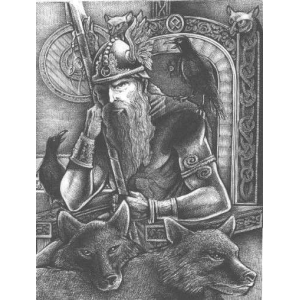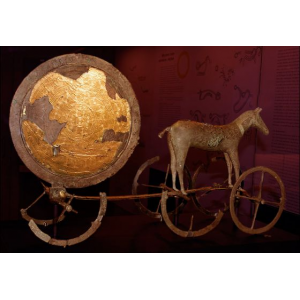
Asatru beliefs:
- Asatru is a polytheistic religion. There are three races of Deities in the Norse pantheon. They are all regarded as living entities who are involved in human life:
1.The ?sir: These are the Gods of the tribe or clan, representing Kingship, order, craft, etc.
2.The Vanir: These represent the fertility of the earth and forces of nature. They are associated with the clan but are not part of it.
3.The Jotnar: These are giants who are in a constant state of war with the ?sir. They represent chaos and destruction. At the battle of Ragnarok, many of the ?sir will die. The world will come to an end and then be reborn.
- Specific Gods: Some of the more important are:
1.Thor is the Thunderer, who wields Mjolnir, the divine Hammer. His chariot racing across the sky generates thunder. Thursday (Thor's Day) was named after him.
2.Odin is the one-eyed God; he gave up one of his eyes in order to drink from the Fountain of Knowledge (some sources say Fountain of Wisdom). He is a magician. He learned the secrets of the runes (Northern European alphabet) by hanging himself on the tree Yggdrasil for nine nights.
3.Frey (a.k.a. Freyr) is the God of fertility, the weather and farming. He was born on the Winter Solstice, typically December 21. His father was Njord.
- Specific Goddesses: Some important ones are:
1.Freya (aka Freyja) is the Goddess of love, beauty and sexuality, and perhaps a dozen other attributes. She leads the Valkyries who take the souls of some slain soldiers to Valhalla (Odin's great hall).
2.Frigg is Odin's wife. Her name has been secularized to a slang term which refers to sexual intercourse. She is the patroness of the household and of married women.
3.Skadi is the Goddess of independence, death, hunting and skiing.
Scandinavia may have been named after her.
4.Ostara, is a Goddess of fertility who is celebrated at the time of the Spring equinox. She was known by the Saxons as Eostre, the Goddess of Spring, from whom we have derived the word Easter. Ostara's symbols are the hare and the egg.
- Other Entities Other Deities are Aegir, Balder, Bragi, Forseti, Heimdall, Hel, Loki, Njord, Ran, Tyr, Ull and Vithar. Followers of Asatru also honor the Landvaettir (land spirits) of the forest, earth and streams.
- Life Values: Asatruars in North America have created a list of Nine Noble Virtues: Courage, Truth, Honor, Fidelity, Discipline, Hospitality, Industriousness, Self-Reliance and Perseverance. The family is greatly valued and honored. They reject any form of
Discrimination based on ethnicity, gender, language, nationality, race, sexual orientation, or "other divisive criteria".
- Origins: Humanity is literally descended from the Gods. Three brothers, Odin, Vili, and Ve created people from two trees and gave them the names Ask and Embla. One deity, Rig visited the earth and established the social classes.
- Od: This is the gift of ecstasy provided to humans by the Gods. It is what separates humanity from other animals, and is our eternal link with the Gods.
- Creation Story: A poem Voluspa (Prophecy of the Seeress) contains an Asatru story of the creation of the universe. Between Muspelheim (The Land of Fire) and Niflheim the Land of Ice was an empty space called Ginnungigap. The fire and ice moved towards each other; when they collided, the universe came into being. Odin, Vili and Ve later created the world from the body of a giant that they had slain.
- After death: Unlike many other religions that have Heaven or Hell as a final destination after death, Norse myths indicate that there are many possible locations. Half of the heroic, battle-slain warriors go to Freyja's field, Folkvangr. She is said to get first pick. Helheim is the neutral realm where most people go upon death. Helheim is ruled by the goddess, Hel (or Hela). Oathbreakers and other dishonorable people are eaten by Niddhog, a dragon. Those who die at sea are said to enter another hall. However, most Asatruar do not believe in the myths literally. Some believe in reincarnation along family lines. Still, others believe that the dead inhabit their graves.
- The end of the world: Ragnar'k (a.k.a. Ragnar'kkr, Ragnar'k, Ragnarok; literally the fate of the Gods) is the anticipated apocalypse. It involves a great battle between the Gods and the J'tnar -- a race of giants with superhuman strength. Unlike
Revelation in the Christian Scriptures, prophecies of Ragnar'k are very specific: the events leading up to the battle, the timing of the battle, who will kill whom, etc. are all known. Wolves will eat the sun and moon. The stars will stop shining. Mountains will fall; trees will be uprooted; "Fumes will reek and flames will burst, scorching the sky with fire. The earth will sink into the sea." Most of the Gods will die. Only one woman and one man, Lifthrasir and Lif, will survive. Their offspring will eventually repopulate the world and live in peace. 11
Free eBooks (Can Be Downloaded):
Aleister Crowley - Leah SublimeTuesday Lobsang Rampa - Three LivesReeves Hall - Asatru In Brief
 Sunna is the sun Goddess. We derive the English word ’Sun’ from her name and Sunday is named for her. Her brother is Manni, the moon. She is known to drive her Chariot across the sky, chased by wolves which seek to devour her. However, she is known for her life-giving Blessings and can be asked for victory blessings.
Sunna is the sun Goddess. We derive the English word ’Sun’ from her name and Sunday is named for her. Her brother is Manni, the moon. She is known to drive her Chariot across the sky, chased by wolves which seek to devour her. However, she is known for her life-giving Blessings and can be asked for victory blessings.